|
|

|
|

|
|
|
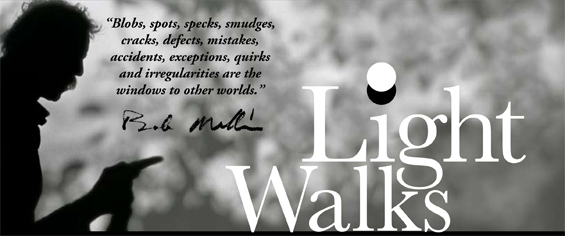

|
|
Friday, July 18 through Sunday, October 5 2008
|

|
|
Light Walks
An Homage to Exploratorium Artist Bob Miller
Works by Kit Kube, Mark Esper, Michael Brown, Michael Walsh, and Jane Aaron
Co-curated by Liz Keim and Pamela Winfrey
These artists use light as a primary tool of exploration. Presenting their medium in all its magical, scientific, and artistic glory, they echo Bob’s approach to the wonders of light. Whether creating images based on Bob’s famous
Light Walks
, playing with phenomena such as the persistence of vision, or simply reveling in the gossamer qualities of reflection, these artists have all been influenced by or are kindred spirits of Bob.
This exhibition honors Bob Miller. To celebrate his enduring impact on the Exploratorium, the museum has established a fund in his name to support a variety of projects consistent with his philosophy and passions, including maintenance of his iconic exhibits, the development of new exhibits, and the creation of a fellowship supporting Artists-in-Residence. If you would like to contribute to this fund, please call the Exploratorium Development Department at (415) 528-4385.
Light Walks
is made possible in part by a grant from Grants for the Arts/San Francisco Hotel Tax Fund.
Bob Miller
(1935-2007)
Bob Miller viewed light as both a subject of study and an object of play. As an artist, he loved to “paint with light,” revealing the brilliant palette within rays of white light. As an inventor, he took inspiration from the everyday world around him, transforming his often startling insights into opportunities for shared discovery. During his decades-long relationship with the Exploratorium, he created some of its most iconic, beautiful, and beloved exhibits—still enjoyed here and at museums around the world.
Joining the Exploratorium in 1970, the year after it opened, Bob stayed on as Artist-in-Residence through 1977, then served as the museum’s Associate Director until 1988. Even in retirement, he continued to build exhibits and share his excitement for “the invisible sea of images” that surrounds us. In addition to his well-known work with light, he also created experiences in sound, mathematics, and cognition. His rigorous investigations even influenced academic research on perception.
Bob’s ability to see light and shadow in unexpected ways continues to shape the Exploratorium’s vision of itself, and offers a pinhole view into our amazing world of images.
|
|
|
About the Artists
|

Enlightenment
Mark Esper
Polycarbonate plastic, electric motors, light-emitting diodes (LEDs), infrared lamp, electronic circuits
Enlightenment
is an interactive installation that manipulates light, creating inverse shadows. It explores several aspects of perception and self-perception. The term “enlightenment” comes from the humanistic and scientific movement of the seventeen hundreds; in this work, the idea of personal enlightenment is made physical, a means of contemplation.
While exploring the poetic arc between science and the humanities through sculptural installations and objects,
Mark Esper
began learning how to design and build electronic circuits and to program micro-controllers. His recent work focuses on viewer interaction, self-organizing form or movement, and emergent behavior.
|

|
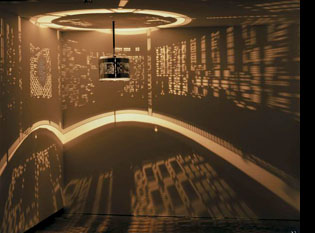 Circadian Snare
Circadian Snare
Kit Kube
Mixed media
This work probes the metaphysics of life. In this sculpture of patterned light, Kube contemplates the soul’s willingness to be, in his words, “snared to take form.” Subjected to an array of physical laws, the incarnated soul is drawn to the attraction of life as well as to the limitations of physical time and space.
Kit Kube
is a kinetic sculptor based in Charlotte, NC. He frequents scrap yards for his materials, drawn to the history, spiritual intimacy, and aesthetic potential of discarded industrial artifacts.
|

|
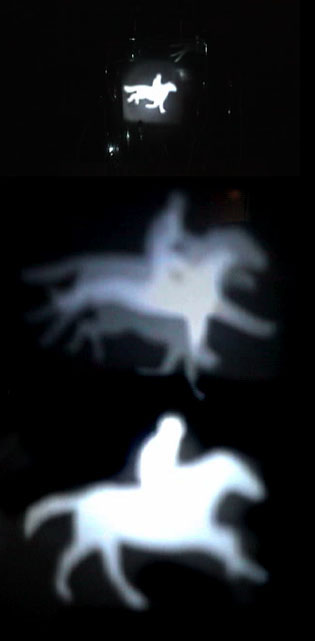
Ghost Horse
Michael Brown
Mirrors, light emitting diodes (LEDs), electronics, bell jar, wood
Ghost Horse
is a visual experiment combining a series of images created by Eadweard Muybridge in the 1870s.
"Leland Stanford wanted to prove that when a horse is trotting, all four hooves are 'simultaneously free from contact with the ground.' Since motion picture technology didn't exist at the time, Muybridge created these images by placing a series of cameras along the path of a running horse. Delicate threads connected to each camera crossed its path, and, when broken, triggered the cameras in sequence.
Intrigued and inspired by Muybridge's technology (or lack thereof), my goal was to explore techniques—using his imagery—to recreate the horse's movement without movement.”
—Michael Brown
Michael Brown
is a San Francisco-based sculptor and installation artist. He loves it when his work can engage others with “pretty,” entice them with intrigue, and inspire opportunities for discovery and invention.
On loan from the collection of Peter Bosch and Darril Hudson
.
|

|
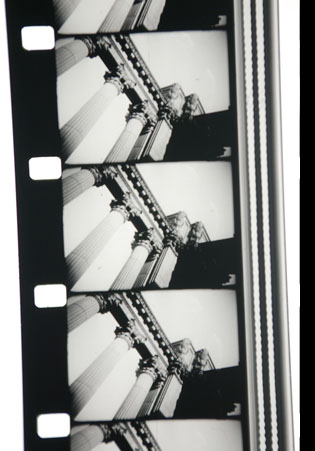 Lightwalk
Lightwalk
Michael Walsh
Looping video (5 minutes, digital transfer from 16mm film) with sound by 20 Miles
Lightwalk
is a cinematic ode to Bob Miller shot one summer afternoon at the Palace of Fine Arts in San Francisco, and the Marin Headlands.
"
This piece was inspired by a walk with artist and keen observer Bob Miller. During this walk, I was enthralled by his brilliant conception of light and how it seduces us. Light reveals the world to us, in all of its beauty and warmth, yet we often take its presence for granted. Its absence— darkness—can be the ultimate despair. Ever since that afternoon I have looked at light differently. A quick blink of the eye causes a retina burn. A pinhole creates a portrait that transfixes me. Amazing effects stream past our retinas while we are busily distracted by our lives. Using in-camera effects, this film attempts to capture everyday images we might overlook." —Michael Walsh
Michael Walsh
is an experimental filmmaker and painter who enjoys roaming through rural and urban landscapes, capturing what he notices on film and in song. He was a lively part of San Francisco's underground cinema art scene until he decided to relocate permanently to Alaska—where the fishing is better!
|

|
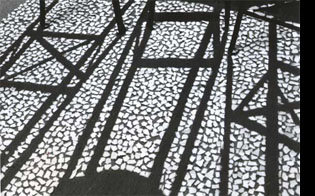
Traveling Light
Jane Aaron
Looping video (3 minutes, digital transfer from 16mm film)
Traveling Light
is a seemingly simple study of the movement of light, with its subtle variations of color, as it travels through a home over the course of a day. The detail in this piece comes from a studied observation of the ways in which light seems to take on a visceral physicality at times. The complexity of its construction is whimsically revealed in the film’s final moments.
Jane Aaron
is a New York-based artist-turned-experimental animator. Highly regarded for her unique approach to stop-motion animation and visual illusions, she has created many short films for Sesame Street, and her animated films have appeared on television as well as in art museums and countless international film festivals and cinema arts programs.
|
|
|
Cinema Arts Program: Umbra and Penumbra
Saturday, July 19 • 2:00 p.m. in the McBean Theater
This selection of films is a cinematic meditation on light and shadow in memory and celebration of long-time Exploratorium artist Bob Miller.
Frame
(1990, 3 min.), by Lew Alquist, observes patterns of reflected and projected light on the surface of an outdoor movie screen over the course of 24 hours.
Lake Orion
(2001, 5 min.), by Michael Walsh, captures memories of summer swimming and picnicking with family by Lake Orion.
Lightplay: Black-White-Grey
(1932, 6 min.), by Laszlo Moholy-Nagy, is a “moving painting”—an abstract interplay of reflective surfaces, beams of light, and dramatic shadows. Laszlo Moholy-Nagy used the Light Prop, one of his installations, to create what is perhaps his most famous film,
Lightplay: Black-White-Grey
. The film follows the Light Prop’s movement in close-up, resulting in an abstract interplay of reflective surfaces, beams of light, and dramatic shadows. Moholy-Nagy likened the film to a ‘moving painting,’ much like Bob Miller’s
Sun Painting,
an installation at the Exploratorium.
Free Radicals
(1958, 5 min.), by renowned experimental animator Len Lye, was made by scratching patterns into black film stock, capturing the rhythms of moving light and the illusion of three-dimensional space.
Curated by Liz Keim
|
|
|
|
|
|
|
|
|
|

|

|
|
|

|